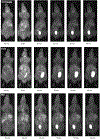Gd3+:DOTA-Modified 2-Hydroxypropyl-β-Cyclodextrin/4-Sulfobutyl Ether-β-Cyclodextrin-Based Polyrotaxanes as Long Circulating High Relaxivity MRI Contrast Agents
- PMID: 30403467
- PMCID: PMC8404830
- DOI: 10.1021/acs.bioconjchem.8b00525
Gd3+:DOTA-Modified 2-Hydroxypropyl-β-Cyclodextrin/4-Sulfobutyl Ether-β-Cyclodextrin-Based Polyrotaxanes as Long Circulating High Relaxivity MRI Contrast Agents
Abstract
A family of five water-soluble Gd3+:1,4,7,10-tetraazacyclododecane-1,4,7-tetraacetic acid-modified polyrotaxane (PR) magnetic resonance contrast agents bearing mixtures of 2-hydroxypropyl-β-cyclodextrin and 4-sulfobutylether-β-cyclodextrin macrocycles threaded onto Pluronic cores were developed as long circulating magnetic resonance contrast agents. Short diethylene glycol diamine spacers were utilized for linking the macrocyclic chelator to the PR scaffold prior to Gd3+ chelation. The PR products were characterized by 1H NMR, gel permeation chromatography/multiangle light scattering, dynamic light scattering, and analytical ultracentrifugation. Nuclear magnetic relaxation dispersion and molar relaxivity measurements at 23 °C revealed that all the PR contrast agents displayed high spin-spin T1 relaxation and spin-lattice T2 relaxation rates relative to a DOTAREM control. When injected at 0.05 mmol Gd/kg body weight in BALB/c mice, the PR contrast agents increased the T1-weighted MR image intensities with longer circulation times in the blood pool than DOTAREM. Excretion of the agents occurred predominantly via the renal or biliary routes depending on the polyrotaxane structure, with the longest circulating L81 Pluronic-based agent showing the highest liver uptake. Proteomic analysis of PR bearing different β-cyclodextrin moieties indicated that lipoproteins were the predominant component associated with these materials after serum exposure, comprising as much as 40% of the total protein corona. We infer from these findings that Gd(III)-modified PR contrast agents are promising long-circulating candidates for blood pool analysis by MRI.
Figures








Similar articles
-
Gd3+-1,4,7,10-Tetraazacyclododecane-1,4,7-triacetic-2-hydroxypropyl-β-cyclodextrin/Pluronic Polyrotaxane as a Long Circulating High Relaxivity MRI Contrast Agent.ACS Appl Mater Interfaces. 2015 Oct 14;7(40):22272-6. doi: 10.1021/acsami.5b05393. Epub 2015 Sep 29. ACS Appl Mater Interfaces. 2015. PMID: 26417911 Free PMC article.
-
Gadolinium Complex of 1,4,7,10-Tetraazacyclododecane-1,4,7-trisacetic Acid (DO3A)-Ethoxybenzyl (EOB) Conjugate as a New Macrocyclic Hepatobiliary MRI Contrast Agent.J Med Chem. 2017 Jun 22;60(12):4861-4868. doi: 10.1021/acs.jmedchem.7b00060. Epub 2017 May 31. J Med Chem. 2017. PMID: 28530407
-
A small MRI contrast agent library of gadolinium(III)-encapsulated supramolecular nanoparticles for improved relaxivity and sensitivity.Biomaterials. 2011 Mar;32(8):2160-5. doi: 10.1016/j.biomaterials.2010.11.043. Epub 2010 Dec 16. Biomaterials. 2011. PMID: 21167594 Free PMC article.
-
PARACEST agents: modulating MRI contrast via water proton exchange.Acc Chem Res. 2003 Oct;36(10):783-90. doi: 10.1021/ar020228m. Acc Chem Res. 2003. PMID: 14567712 Review.
-
Polydisulfide Gd(III) chelates as biodegradable macromolecular magnetic resonance imaging contrast agents.Int J Nanomedicine. 2006;1(1):31-40. doi: 10.2147/nano.2006.1.1.31. Int J Nanomedicine. 2006. PMID: 17722260 Free PMC article. Review.
Cited by
-
Structure-function relationships of cholesterol mobilization from the endo-lysosome compartment of NPC1-deficient human cells by β-CD polyrotaxanes.PLoS One. 2022 Dec 30;17(12):e0268613. doi: 10.1371/journal.pone.0268613. eCollection 2022. PLoS One. 2022. PMID: 36584173 Free PMC article.
-
Cyclodextrins: promising scaffolds for MRI contrast agents.RSC Adv. 2021 Sep 17;11(47):29762-29785. doi: 10.1039/d1ra04084g. eCollection 2021 Sep 1. RSC Adv. 2021. PMID: 35479531 Free PMC article. Review.
-
Supramolecular polyrotaxane-based nano-theranostics enable cancer-cell stiffening for enhanced T-cell-mediated anticancer immunotherapy.Nat Commun. 2025 Mar 8;16(1):2331. doi: 10.1038/s41467-025-57718-5. Nat Commun. 2025. PMID: 40057488 Free PMC article.
-
Quantum Dots and Gd3+ Chelates: Advances and Challenges Towards Bimodal Nanoprobes for Magnetic Resonance and Optical Imaging.Top Curr Chem (Cham). 2021 Feb 7;379(2):12. doi: 10.1007/s41061-021-00325-x. Top Curr Chem (Cham). 2021. PMID: 33550491 Review.
-
Cyclodextrin-based rotaxanes as a versatile platform for biological and medicinal applications.Commun Chem. 2025 May 14;8(1):149. doi: 10.1038/s42004-025-01555-6. Commun Chem. 2025. PMID: 40360722 Free PMC article. Review.
References
-
- Frullano L, and Meade TJ (2007) Multimodal MRI contrast agents. J. Biol. Inorg. Chem 12, 939–49. - PubMed
-
- Lauffer RB (1987) Paramagnetic metal complexes as water proton relaxation agents for NMR imaging: theory and design. Chem. Rev 87, 901–927.
Publication types
MeSH terms
Substances
Grants and funding
LinkOut - more resources
Full Text Sources
Medical
Research Materials

